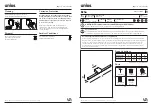
MicroHarmony Cell Sizes 40 - 260A Manual
Repair Hints
19001467: Version 1.0
8-1
s
8
8.1 Reporting Failures
Cell failures or component failures must be reported to both the quality group and product development.
8.2 Approved Components
Always refer to the archived BOM and assembly drawings for approved component part numbers and procedures
when repairing any cell. Failure to use components not specifically listed on the BOM may result in poor cell
performance or further failures.
8.3 Basic Rules
1.
Never parallel or series non-identical manufacturer's part numbers (or Siemens MDIT numbers) for IGBTs
or electrolytic capacitors in the same power cell, even if these part numbers are approved as 1
st
, 2
nd
, or 3
rd
sources on the BOM.
2.
Never substitute a non-specified cell control board/gate clamp board (or any specified component or
subassembly) without formal approval from the Product Development Group.
3.
Never change an input power fuse(s) without first determining the root cause for the fuse operation. Fuses
are not designed to protect components in the power cell against overload. If a fuse(s) open, there is usually
a component failure within the cell. Re-application of rated power may cause catastrophic damage.
4.
In cases where the archived BOM specifies obsolete components that can no longer be procured, and the
substitution of an alternative cell(s) is not available or commercially not feasible, contact the Product
Development Group for assistance. In such events, Product Development may suggest alternative
components only after sufficient technical review and verification. In these instances, it will be Product
Development's responsibility to generate the required ECR and obsolescence information. It will be the
repair department’s responsibility to make the required label changes and notify Application Engineering
and Field Service of the part number revision.
8.4 General Repair Hints and Procedures
1.
Input fuse(s) or control fuse(s) opening is almost always an indication of component failure in a cell.
2.
Damage to the chassis ground wire is always an indication of an insulation failure internal to the power
circuit or its components, or the result of arcing between the power circuit and chassis. Always perform the
appropriate HIPOT test or look for arc damage.
3.
A capacitor failure, which results in venting, bulging, or header expulsion, is usually caused by sustained
over voltage of 15 to 20% above its operating voltage rating.
4.
If one or more capacitors have failed, but only in a particular parallel group, and there this no indication of
other component damage, look for a shorted or high leakage capacitor in the other parallel groups.
5.
If capacitor damage is apparent in all parallel groups and there is further damage to the IGBTs or control
board, over voltage to the cell resulted from an outside source. Power fuses opening may indicate that an
over voltage was generated from the power transformer.
6.
Over voltage damage may have also occurred from an output source. This is rare since the cells can protect
themselves against this type of over voltage.
CHAPTER
8
Repair Hints
Summary of Contents for Eupec
Page 16: ...Cell Overview MicroHarmony Cell Sizes 40 260A Manual 1 6 19001467 Version 1 0 s 1 ...
Page 36: ...Installation MicroHarmony Cell Sizes 40 260A Manual 3 4 19001467 Version 1 0 s 3 ...
Page 42: ...Electrical Description MicroHarmony Cell Sizes 40 260A Manual 4 6 19001467 Version 1 0 s 4 ...
Page 56: ...Repair Hints MicroHarmony Cell Sizes 40 260A Manual 8 4 19001467 Version 1 0 s 8 ...
Page 76: ...Drive Calc Express MicroHarmony Cell Sizes 40 260A Manual 10 2 19001467 Version 1 0 s 10 ...
Page 86: ...Communication Protocol MicroHarmony Cell Sizes 40 260A Manual 11 10 19001467 Version 1 0 s 11 ...
Page 87: ...MicroHarmony Cell Sizes 40 260A Manual NOTES 19001467 Version 1 0 N 1 s NOTES ...
Page 88: ...NOTES MicroHarmony Cell Sizes 40 260A Manual N 2 19001467 Version 1 0 s ...
Page 89: ...MicroHarmony Cell Sizes 40 260A Manual NOTES 19001467 Version 1 0 N 3 s ...
Page 90: ...NOTES MicroHarmony Cell Sizes 40 260A Manual N 4 19001467 Version 1 0 s ...
















































